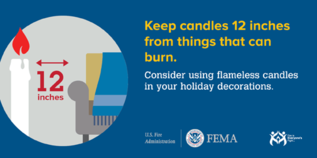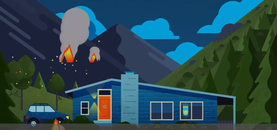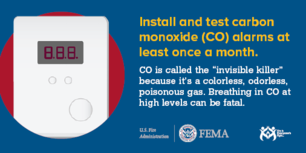
|
 Entertaining
and celebrating with family and friends is what the holiday season is all
about.
This year, take some time to learn about potential fire hazards related
to cooking, candles, decorations, electrical cords, and heating devices.
Keep
your holiday parties safe with these U.S. Fire Administration (USFA) tips:
- Test your smoke alarms and tell your guests about your home fire escape plan.
- Keep children and pets away from lit candles.
- Keep matches and lighters up high in a locked cabinet.
- Stay in the kitchen when cooking at high temperatures like
frying, grilling or broiling.
- Ask people who smoke to smoke outside. Remind smokers to keep
their smoking materials with them, so young children do not touch them.
- Keep doorways and exit paths clear of furniture and
decorations.
Find more holiday and fire safety information
on the USFA Holiday Safety page.
|
 With several active wildfires
affecting the Western United States, it is important to know how to stay safe
with information and resources from Prepareathon™.
Wildfires can happen
anywhere in the country and at any time of year. If you see a wildfire approaching,
call 911 to report the fire. Do not assume that someone else reported it and
follow these tips from Prepareathon’s How to Prepare
for a Wildfire Guide:
If
ordered to evacuate:
- Leave immediately.
- Help firefighters, if there
is time before you leave. Some of the things to help include closing up the
house and leaving lights on for visibility, as well as moving flammable
materials to the center of the home, away from windows. You can also leave
hoses connected to a water source, so they are available for the fire department.
- Text SHELTER and your ZIP
code (e.g., SHELTER 20472) to 43362 (4FEMA) to find the nearest shelter in your
area. Follow local media for more information on shelters.
If
trapped in your home:
- Call 9-1-1 and provide your
location, if possible. Please be aware that during a major event such as a
wildfire, emergency services may be overwhelmed, and a response may be delayed
or impossible.
- Turn on the lights to
increase the visibility of your home in heavy smoke.
- Keep doors, windows, vents,
and fire screens closed.
- Keep your doors unlocked.
- Move flammable materials
(e.g., curtains, furniture) away from windows and sliding glass doors.
- Fill sinks and tubs with
water to assist in dousing small smoldering fires, which may pop up.
- Stay inside, away from
outside walls and windows.
For more information
on wildfire safety, review Prepareathon’s How to Prepare
for a Wildfire guide, or watch the When the Fire Starts video. You can also
read about California’s use of FEMA’s Wireless Emergency Alerts during the recent
wildfires.
|
 Carbon monoxide (CO) is the “invisible killer” because it is a
colorless, odorless, and poisonous gas.
According to the U.S. Fire Administration (USFA), more than 150
people in the United States die every year from accidental nonfire-related CO
poisoning from household products, like generators. Other products include
faulty, improperly-used or incorrectly-vented, fuel-burning appliances such as
furnaces, stoves, water heaters, and fireplaces.
Breathe easy this winter and avoid CO poisoning with these USFA tips:
- Install and maintain CO alarms in a central location outside
each separate sleeping area and on every level of your home to provide an early
warning of CO.
- Use portable generators outdoors in well-ventilated areas
away from all doors, windows, and vents.
- Make sure vents for the dryer, furnace, stove, and fireplace
are clear of snow and other debris.
Learn the symptoms of CO poisoning
and other CO safety information on the USFA Carbon Monoxide Safety page.
|
On Wednesday, December 13, the Federal Emergency Management Agency’s
Individual and Community Preparedness Division invites you to a webinar
featuring several Community Emergency Response Team (CERT) programs from
Florida, Texas and California to share their experiences and lessons learned
from responding to the recent disasters. This webinar will also provide you
with an opportunity to ask questions and share your knowledge.
Title: CERT Webinar: Sharing
Lessons Learned from Recent Disasters
Date: Wednesday, December 13, 2017
Time: 3:00 – 4:30 p.m. EDT
Speakers:
-
James
Cunningham,
North Collier Fire Rescue, Florida
-
Christy Rojas, CERT Program Manager,
Volunteer Florida
-
John Ignatcyzk and Christopher Winn,
Los Angeles City Fire Department, California
-
Jake Heflin, Long Beach City Fire,
California
-
Lisa Rubey, New Braunfels CERT, Texas
-
Doris Hermann, Galveston County CERT,
Texas
How to Join the Webinar:
We hope you will be able to join us on December 13!
Disclaimer: The reader recognizes
that the federal government provides links and informational data on various
disaster preparedness resources and events and does not endorse any non-federal
events, entities, organizations, services, or products. Please let us know
about other events and services for individual and community preparedness that
could be included in future newsletters by contacting citizencorps@fema.dhs.gov.
|

|